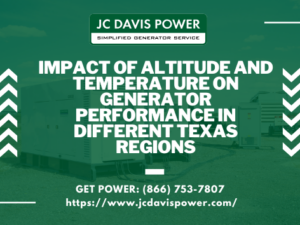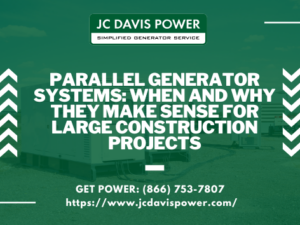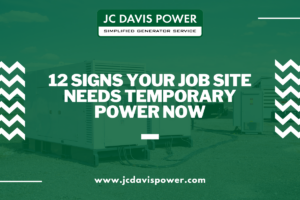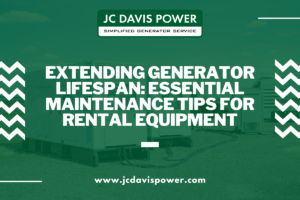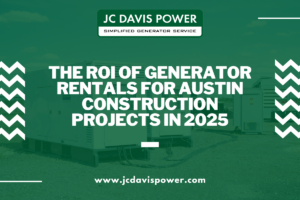When you’re running a massive construction project, parallel generator systems can be a game-changer. These setups connect multiple generators to work together, giving you built-in backup power, better fuel efficiency, and the flexibility to match your exact power needs without wasting energy or money.
Here’s Why Power Reliability Matters More Than Ever
Let’s be honest – construction projects are already walking a tightrope. The numbers don’t lie: 98% of mega projects face delays or budget overruns, and large construction projects typically run 20% behind schedule while going as much as 80% over budget.
Now add power problems to that mix, and you’re looking at serious trouble. The U.S. economy loses between $28 billion and $169 billion annually due to power outages. When your project is already fighting against the odds, you can’t afford to let power issues push you further behind.
That’s where parallel generators come in. Instead of putting all your eggs in one basket with a single massive generator, you’re spreading the risk and gaining flexibility that can actually save your project timeline and budget.
What Exactly Are Parallel Generator Systems?
Think of parallel generators like having a team instead of relying on one superstar player. You’ve got multiple generators connected through a control system that lets them share the electrical load. When one generator can’t handle everything alone, the others jump in to help.
Here’s the cool part: the system is smart enough to balance the load automatically. If your power needs are light, maybe only one generator runs. When you fire up those heavy-duty concrete pumps or tower cranes, additional generators kick in seamlessly.
The load sharing technology ensures each generator carries its fair share of the electrical demand. This isn’t just about having backup power – it’s about having intelligent power management that adapts to your construction site’s changing needs throughout the day.
The Three Big Reasons Parallel Systems Make Sense for Large Construction
Power Redundancy That Actually Works
When you’re running a single 500kW generator and it goes down, your entire operation stops. With parallel generators, you might have four 125kW units working together. If one fails, you still have 375kW of power keeping critical systems running while you address the problem.
This redundancy isn’t just theoretical. On large construction power applications, equipment failures are part of life. Having built-in backup means the difference between a minor hiccup and a project-stopping disaster.
Load-Matching Efficiency That Saves Real Money
Here’s where parallel systems really shine. Construction sites don’t use steady power all day long. You might need 300kW during peak concrete pours but only 75kW during setup times.
With a single large generator, you’re running that big unit even when you only need a fraction of its output. That’s like driving a semi-truck to pick up groceries – it works, but it’s wasteful. Parallel generators let you match your power production to your actual needs, which can cut fuel costs by 15-25% on many projects.
Maintenance Flexibility Without Shutdowns
This might be the biggest advantage that project managers don’t think about upfront. When your single generator needs maintenance, your whole project stops. With parallel generators, you can take units offline for service while others keep working.
Studies show that running generators in parallel can extend maintenance intervals by 15-20% compared to single generator operation, thanks to shared load reducing stress on individual units. Plus, you can schedule maintenance during lower-demand periods without affecting critical operations.
You Might Wonder: When Do Parallel Systems Actually Make Financial Sense?
The break-even point usually hits around 200-300kW of total power needs, but it’s not just about size. Here are the situations where parallel generators typically pay for themselves:
- Projects lasting 6+ months: The fuel savings and reduced downtime risk justify the higher initial setup costs
- Sites with highly variable power loads: If your demand swings dramatically throughout the day, load-matching efficiency adds up quickly
- Critical timeline projects: When delays cost more than the premium for redundant power, parallel systems become insurance that pays for itself
- Remote locations: Where getting replacement equipment quickly is expensive or difficult
For context, consider that large construction power requirements often involve multiple phases with different electrical demands. A parallel system can adapt as your project evolves, rather than requiring completely new equipment.
The Important Thing to Know About Setup and Management
Setting up parallel generators isn’t as simple as plugging in multiple units. You need:
Proper Load-Sharing Controls: The system needs smart controls that automatically balance electrical loads between units. Without this, you’ll have generators fighting each other instead of working together.
Synchronized Electrical Output: All generators must produce power at exactly the same frequency and voltage. This requires synchronization panels that constantly monitor and adjust each unit’s output.
Professional Installation: Unlike single-generator setups, parallel systems need experienced technicians who understand load-sharing principles and safety protocols.
Regular System Testing: The control systems need periodic testing to ensure they’ll respond correctly when loads change or units fail.
The good news? Working with experienced generator rental services in Texas means you get professional setup, monitoring, and maintenance as part of the package.
Real-World Applications Where Parallel Systems Shine
High-Rise Construction: As buildings go up, power needs change dramatically. Early foundation work might need 150kW, while full construction with multiple tower cranes and concrete pumps could demand 600kW. Parallel systems adapt without requiring complete equipment swaps.
Infrastructure Projects: Highway construction, bridge building, and similar projects often have peak power periods followed by lower-demand phases. Load-matching capability prevents fuel waste during lighter work periods.
Industrial Construction: Manufacturing facilities and processing plants require consistent power for critical systems while accommodating variable construction loads. Redundancy becomes essential when power interruptions could damage sensitive equipment.
For projects in major Texas markets like Dallas generator rental or San Antonio generator rental, parallel systems also help manage the challenges of urban construction where backup power regulations may be stricter.
The Bottom Line: Is Parallel Right for Your Project?
Parallel generator systems make the most sense when you’ve got significant power needs, project duration long enough to realize efficiency benefits, and situations where downtime costs more than the premium for redundant power.
They’re not the right choice for every project. Smaller jobs or short-term work might be better served with single generators. But for major construction projects where power reliability directly impacts your timeline and budget, parallel systems offer protection that often pays for itself.
The construction industry is already dealing with enough challenges – 79% of contractors now use software to manage information and avoid the problems that cause 14% of construction rework globally. Smart power management through parallel generators is just another tool to keep your project on track.
Ready to explore whether parallel generators make sense for your specific project? The key is working with power generation specialists who can analyze your actual needs and recommend solutions that fit your timeline, budget, and risk tolerance. After all, when 98% of mega projects face delays or overruns, every advantage counts.
FAQs:
1. Are parallel systems more complex to operate day-to-day?
Actually, they’re often simpler for your crew. The control system handles load balancing automatically, so operators don’t need to constantly monitor power levels or manually start additional units when demand increases.
2. What happens if the control system fails?
Quality parallel setups include backup control systems and manual override capabilities. In worst-case scenarios, individual generators can often be operated independently until repairs are made.
3. Do I need special electrical infrastructure?
Yes, but it’s typically handled by the rental company. The electrical distribution needs to accommodate multiple power sources, which requires specialized switchgear and monitoring equipment.
4. How much more do parallel systems cost compared to single generators?
Initial rental costs are typically 15-30% higher than single-generator setups, but most large projects save money overall through improved efficiency and reduced downtime risk.
